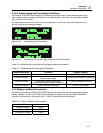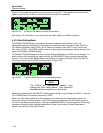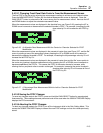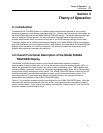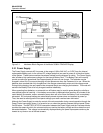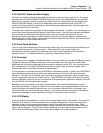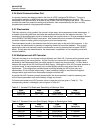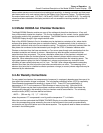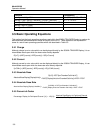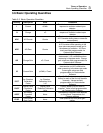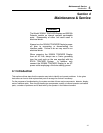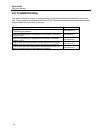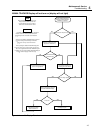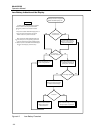
Theory of Operation
Overall Functional Description of the Model 35360A Tracker Display
3
3-5
Above values assume nominal electrical and radiological sensitivity, air density correction and front panel
gain factors set to unity, and nominal value for the Display Units Conversion Factors. The following unity
conversion factors were used; 3.52 R/nC, 0.879 rad/R, 0.00879 Gy/R, and 0.00879 Sv/R. The sensitivity
values have been selected so the display resolution will not exceed the resolving capability of the A-D
converter.
3.3 Model 35300A Ion Chamber Detectors
The Model 35300A Detector contains an array of four orthogonal placed ion chambers on 10 cm radii
from a fifth centrally located ion chamber. The five ion chambers are of a vented, circular, parallel-plate
configuration and are fully guarded for low leakage. The 35300A Detector connects to the 35360A
TRACKER Display through a light weight interface cable.
Each of the 35300A Detector's five ion chambers may be depicted as containers of air, whose inside
surfaces (bias plates) have been given a conductive coating. Located centrally in the air volume is a
plastic disc (collector) which also has a conductive coating. The collector is electrically insulated from the
bias plates and connected to the electrometer input through the 37783-15 detector interface cable.
Photons or electrons from the linear accelerator or Co
60
source pass through and are absorbed into the
chamber's materials and internal air volume. Absorption may also take place in external build-up
materials when they are present. The primary absorption takes place in the chamber's windows and
build-up materials when the incident photons or primary electrons interact with the atoms of these
materials. When absorption occurs, high speed electrons are emitted from the interacting atoms. The
high speed electrons spray into the ion chamber's air volume and produce many ionization tracks
consisting of lower velocity electrons and "air" ions. The 300 V bias voltage separates the secondary
electron cloud from the cloud of positive ions before recombination can occur. The sweeping of the
electron cloud onto the ion chamber's collector produces a charge (or current) whose magnitude may be
measured by the electrometer.
3.4 Air Density Corrections
For any vented ion chamber, the measurement of exposure (in roentgens) depends upon the mass of air
from which the ionization charge is collected. The ion chamber calibration factors (ICCF's) supplied by
Fluke Biomedical expresses this sensitivity in terms of R/nC. These ICCF's are specified for a
temperature of 22 °C and a pressure of 760 millimeters of mercury (mm Hg). Since the 90100
TRACKER System may be used under ambient conditions which significantly differ from these, the
corresponding changes in the sensitivity of the ion chamber must be accounted for. The air density
correction factor (ADCF) has been defined as follows:
ADCF = (760 mm Hg / P) * (T / 295.15 K)
where the pressure "P" is expressed in mm Hg and the temperature "T" is in Kelvin.
When the user has customized the 35360A TRACKER Display to use other temperature and pressure
units, the corresponding values entered by the user at the instrument's front panel are automatically
converted to mm Hg and K before use in the above equation. The equations used for these conversions
are listed in the following table.



